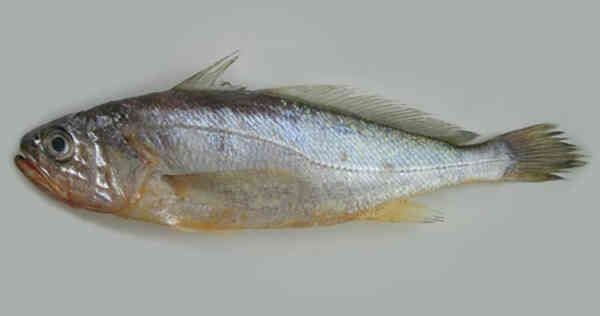
Alias Larimichthys polyactis,Small yellow croaker, plum, plum fish, small king fish, small fresh, small spring fish, small cucumber fish, thick scale fish, flower fish, big eye, ancient fish, yellow scale f
Family Perciformes Sciaenidae Y.croaker
Small yellow croaker is a warm-temperate bottom-dwelling schooling migratory fish. It usually inhabits soft mud or muddy sea areas, and its vertical movement phenomenon will enter the estuary area. It hates strong light and likes turbid water. It rises at dusk and descends at dawn. It often inhabits the bottom or near the bottom during the day. The swim bladder can make sounds, and it will make a "crackling" sound during the reproductive period; when the fish school is dense, the sound is like boiling water or pine waves; in the early summer of the reproductive season, it will gather and migrate to the shallow waters near the estuary or islands and inner bays, and swim into deeper waters in autumn and winter. The depth of the water in the East China Sea in winter is generally not more than 100 meters.

The main food of small yellow croaker in the East China Sea is planktonic crustaceans, and it also preys on decapods and other juvenile fish. The food composition is related to the sea area, season, tide and different growth stages of the fish. The stomach contents are composed of copepods, iridescent fish, isopods, amphipods, krill, decapods and other crustaceans, accounting for about 40%, eels, sardines, yellow crucian carp, dragonhead fish, luminous bream, fine-striped cardinalfish and fish eggs, accounting for about 4%, and others include squid and arrow worms. For juveniles with a body length of more than 11 mm, the main food is copepods such as the two-spined spindle dart, Pacific dart, true spiny lip dart, abdominal needle dart, and Tang's pseudo-dart; long-fronted spiny shrimp of the mysid family; strong arrow worms of the chaetognath family; crustaceans and goby juveniles. The food conversion phenomenon of juveniles is obvious at each development stage. When the body length is between 9 and 20 mm, the two-spined spindle dart is the main food; when the body length reaches 16 mm, it swallows larger shrimps and small fish, but still eats plankton; when the body length reaches 81 mm, the main food is spindle-bellied brown shrimp, goby, and small fish. The feeding of adult fish can be divided into four periods in a year, namely, the feeding intensity is very strong before spawning, mainly Pacific krill; stop feeding during the spawning period; the feeding intensity is very weak at the beginning of the feeding period, and the empty stomach rate reaches 70% to 80%, and then the empty stomach rate gradually decreases; the main food during the wintering period is Pacific krill and fish.
Yellow croaker is one of the four major marine economic fish species in China. It has always been the main target of mass fisheries and motor trawling in the Yellow Sea, Bohai Sea and East China Sea. It is also a resource used by China, South Korea and Japan. In addition to fresh food, dried yellow croaker is also very popular in the market. Otoliths are cold in nature, sweet and salty in taste, and have the functions of astringing and detoxifying, clearing heat and relieving stranguria; swim bladder is neutral in nature, sweet and powerful in taste, and has the functions of nourishing yin and essence, nourishing blood and stopping bleeding, and moistening the lungs and strengthening the spleen.